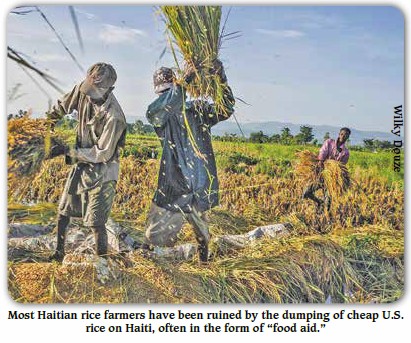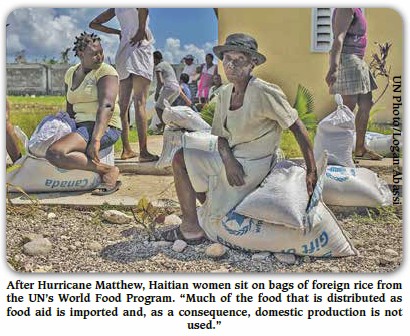|
 At the beginning of October 2016, Hurricane Matthew
ripped through three of Haiti’s southern departments
(Nippes, South, and Grand'Anse), causing terrible
destruction. Along with infectious diseases, such as
cholera, hunger has spiked in the aftermath."The people are desperate, their plantations
destroyed and difficult to access. Hunger is at the
door." This was the cry for help of the residents of
Counoubois, a rural section of Chambelan in the
Grand'Anse region that went viral on social media
networks for several days after Hurricane Matthew passed
through.
Grand'Anse is Haiti’s bread-basket, but now its
agriculture is more than 80% destroyed. In other
regions, food stores have suffered serious damage, and
the availability of local produce is reduced. Livestock
has been lost in some areas, fishing is paralyzed, all
subsistence crops have been lost, and fruit trees have
been severely damaged. Matthew left at least 546 dead,
128 missing, and 2.1 million victims throughout the
country, according to Haitian authorities.
The history of Counoubois symbolizes the reality
of many hard-hit rural regions, which are not easily
accessible due to the lack of infrastructure. About 1.4
million Haitians need food assistance, more than half of
them –
800,000 – urgent food assistance, according to an
emergency assessment carried out by the Haitian
government, the National Organization for Food Security
(CNSA), the World Food Program (WFP) and the Food and
Agriculture Organization of the United Nations (FAO).
The report they produced at the end of October
confirms "the pressing need to provide immediate food
assistance and to help rebuild people's livelihoods."
"If we do not act now to provide them the grains,
fertilizers, and other materials they need, they will
not be able to plant and will face persistent food
insecurity," said Nathanaël Hishamunda, the FAO’s Haiti
representative.
Hurricane Matthew has worsened a situation that
was already complicated. For five years, Haiti has been
ranked among the world’s 15 most hungry countries.
Almost 75% of the population lives in poverty, with
millions of people living in extreme poverty. Before the
hurricane, getting enough to eat in Haiti was already a
luxury for many. By August 2016, the number of people in
a situation of food insecurity was close to 3.2 million.
As with previous disasters, most international
humanitarian aid consists essentially of thousands of
tons of food distributed in certain key affected areas.
But what explains the constant hunger that prevails in
Haiti?
A History of Poverty
"Poverty in Haiti is not a natural
phenomenon,” explained Haitian sociologist Franck Seguy.
“History records its process and progress. The process
has been done in collaboration with Haitians, not with
all of them, but with government leaders and the ruling
class allied with the international bourgeoisie, in
particular in the United States and its farmers. Looking
for markets, they identified Haiti as an ideal place to
sell U.S. products. To do this, they are forced to
systematically destroy Haiti’s domestic production,
which is precisely what has been done until now.”
According to Seguy, after its 1804 revolution,
Haiti was forced to compensate France. To pay this debt,
Haitian governments used domestic production, including
coffee, sold to speculators who paid taxes to the state.
Given that between 1825 and 1922 Haiti’s bourgeoisie did
not pay taxes, payment of the “independence debt” came
essentially from the sweat of farmers.
The leading role of other countries in creating
the objective conditions for Haiti’s hunger is often
ignored. In 1825, the King of France, Charles X, forced
Haiti, which had proclaimed its independence 21 years
earlier after defeating Napoleon's army, to sign a
treaty where, in return for recognition of the new
nation, France would receive a compensation of 150
million gold francs. That amount was to be paid within
five years.
Unfortunately, the sum represented 10 years of
Haiti’s tax revenue. Jean Pierre Boyer, Haiti’s
president at the time, had no choice but to accept, as
France’s negotiators were accompanied by a flotilla of
14 warships.
"From Haiti’s independence in 1804 until today,
debt contributes to the creation of hunger,” said
Professor Seguy. “Most of the funds that the state could
have invested in domestic production were used to pay
interest on the debt."
Since the 1980s, international actors such as the
World Bank (WB), the International Monetary Fund (IMF)
and the U.S. government have imposed neoliberal economic
policies on Haitian rulers. In Seguy’s view, this
constitute "the recipe for a debt crisis."
From this period and until now, every World Bank
project and every new loan from the IMF, including
Haiti's debt restructuring and cancellation, has been
conditioned on, among other things, more adjustments,
privatization of public companies, elimination of
subsidies, deregulation of labor markets, liberalization
of markets, reduction of tariffs, and elimination of
barriers to free trade.
Neoliberal Policies
In 1995, under the pressure from
Washington, President Jean-Bertrand Aristide’s
government reduced practically to zero the tariffs on
several foodstuffs. The IMF demanded this as a condition
that the U.S. government imposed on Aristide to be able
to return to the country after the 1991 coup. Thus,
taxes on imported rice went from 35% to 3%. Haiti became
the country with the lowest customs tariffs in the
Caribbean.
Former U.S. President Bill Clinton (1993-2001)
played a leading role in deepening Haiti's hunger.
During his time as governor of Arkansas – a major rice
producer – and as president, he helped weaken Haiti’s
domestic rice production (a strategic product) in favor
of Arkansas growers looking for new markets for their
products.
"It destroyed Haiti’s potential by invading with
cheap rice,” explained Professor Seguy. “From that
moment on, rice producers in the Artibonite Valley could
not find a market for their product and could not afford
to grow. When they stopped growing, imported rice
producers increased their prices in order to recover
their losses and make a profit."
In 2005, the Haitian government spent $52 million
to repay debt arrears to the World Bank in a period when
the country could have used the money to deal with
various structural problems.
In his "mea culpa" in 2010, Bill Clinton
acknowledges having made the wrong decision in trying to
solve Haiti’s problem of hunger by filling the Haitian
market with rice imported from the United States. He
admits that this decision hurt small Haitian farmers and
producers by abruptly reducing domestic production.
Even today, it is easier and cheaper to buy
American rice in Haitian markets than that produced in
Haiti. This has led to the impoverishment of thousands
of peasant families who have left the countryside to
live in city slums. In the 1970s and 1980s, Haiti had
98% grain self-sufficiency. Today, it imports almost
everything.
In 2006, a report from Christian Aid revealed
that the results of Haiti’s lowered tariffs
"have been disastrous." In this sense, excessive
trade liberalization is closely related to falling
agricultural production, growing poverty, exodus from
the countryside to poor neighborhoods, and increasing
hunger, according to the NGO.
These radical policies have crowned more than 200
years of what the Haitian economist Fred Doura calls an
"extroverted" economy of a country totally "dominated
and exploited" by foreign powers like France and the
U.S., among others.
Humanitarian aid has its share of contributing to
creating hunger in Haiti. Much of the food that is
distributed as food aid is imported and, as a
consequence, domestic production is not used, as has
been seen in the days following Hurricane Matthew, just
like after the January 2010 earthquake.
In these cases, instead of strengthening the
country's capacity by buying directly from Haitian
farmers who could in turn reinvest, products are
imported from the Dominican Republic and the United
States, which destroys national production.
The
original version of this article was first published by
Spain’s El Diario and is the second in a series of
articles and specials of the FAM project
(www.projectefam.cc) on hunger, in collaboration with
eldiario.es. |